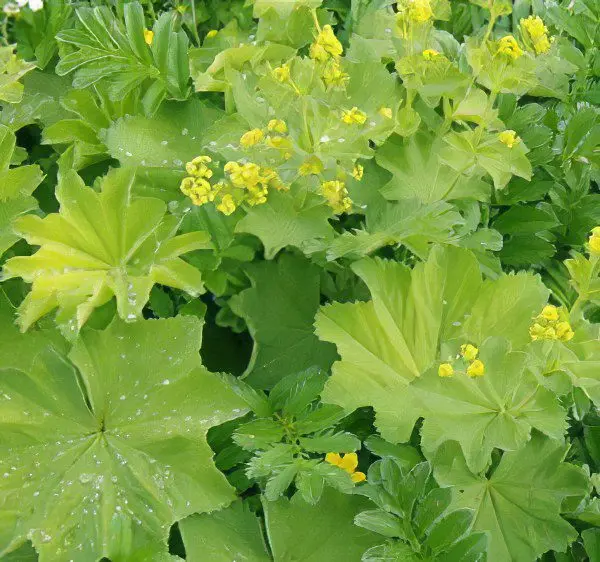Contents
Cultivation, useful properties and recipes for the use of an ordinary cuff
Botanical characteristics of the cuff

Cuff is a perennial plant with creeping stems belonging to the Rosaceae family. The plant can be not only green, but also yellow-green. The rhizome at the cuff is in a horizontal position. The stems of the plant are erect. Leaves have venation. The cuff flowers are yellow, collected in an inflorescence, which can either consist of a small number of flowers or contain a large number of them. The fruit of the cuff is a nut, which is located in the receptacle with an existing calyx. The seeds of the plant are small but numerous. A plant does not need fertilization to bear fruit. Flowering cuff begins in early summer and lasts the entire summer period.
The cuff may bloom a second time in autumn. It is found throughout the CIS – in meadows, near rivers and houses, in forests with a small amount of vegetation.
Growing cuff
Reproduction. The cuff can be propagated by seeds or cuttings. If the seed method is chosen, then the sowing of seeds must be done in boxes or other containers. And after the emergence of seedlings, they are transplanted to a permanent place. If you want to see the cuff bloom in the summer, then you need to plant the seeds in the fall. At home, it is necessary to provide the plant with drainage, for example, pebbles can be placed on the bottom of a pot with a cuff.
The second method of reproduction is plots. This method involves planting already overgrown bushes. To do this, you need to slowly divide the cuff into parts and transplant the already separated parts of the plant (plot) into the prepared soil. The soil should contain clay and peat. Already germinated plants are transplanted to a permanent place, keeping a distance of 30 cm between them. This method of reproduction should be carried out in early spring.
Cuff care. The main rule for growing a cuff is regular watering and pruning of unnecessary shoots. You need to transplant the plant in a sunny place, but the cuff will also withstand the shade. The soil needs fertilizer. The cuff grows rapidly, so its growth must be carefully monitored. The plant behaves differently at home, for example, bright sunlight can either improve the growth of the cuff, or, conversely, slow down the development of the plant. In summer, the cuff should be watered abundantly and often. But there should be no stagnation of water, as this will lead to the death of the plant. The cuff prefers fertile soil.
Useful properties of the cuff
The ground part of the plant contains catechins, tannins, lipids, flavonoids and acids – derivatives of phenol carboxylic acids. The cuff is a storehouse of iron, manganese, ascorbic acid and boron with zinc.
The cuff is used by women for various gynecological diseases. The plant lowers blood cholesterol levels. The cuff has a hemostatic property, so it is used for bleeding.
The cuff is recommended for lactating women because it has a positive effect on lactation. The plant has expectorant, diuretic and anti-inflammatory properties. The cuff is used during childbirth as an aid.
Cuff application

The cuff has long been used in folk medicine in the form of infusions, decoctions and tinctures. For example, an infusion of the cuff helps to restore the menstrual cycle. Tincture of the cuff heals cavities in pulmonary tuberculosis. The same tincture can cure dysbacteriosis.
The cuff is used for tonsillitis, tonsillitis and other inflammations of the throat and mouth. An infusion of the cuff is used as an external agent for ulcers, purulent wounds, dislocations, bruises, and even sprains. In diabetes, it is recommended to take drugs from the cuff. If the metabolism is disturbed, then the cuff will come to the rescue. The plant helps to restore the spinal cord after an illness.
Infusion of the cuff for heavy menstruation. Take 3 teaspoons of cuff herb and pour 250 ml of boiling water over them. Leave for 2 hours to brew. After straining the finished infusion, it must be squeezed out. Take the infusion 4 times a day, 100 ml before meals.
Juice cuff. In order to make juice, you need to take the young leaves and stems of the plant and squeeze the juice out of them. For diarrhea, take 2 teaspoon of juice every 1 hours. Juice mixed with milk in a ratio of 1:10 is used externally.
Cuff tincture. To prepare it, you need to take 5 grams of grass and pour 170 ml of wine over them, leave everything to infuse for 24 hours. After straining, the finished tincture is taken three times a day, 1 tablespoon.
Contraindications to the use of the cuff
To date, no contraindications to the use of drugs from this medicinal plant have been identified. If taken in large doses and in unlimited quantities, this will cause diarrhea.









